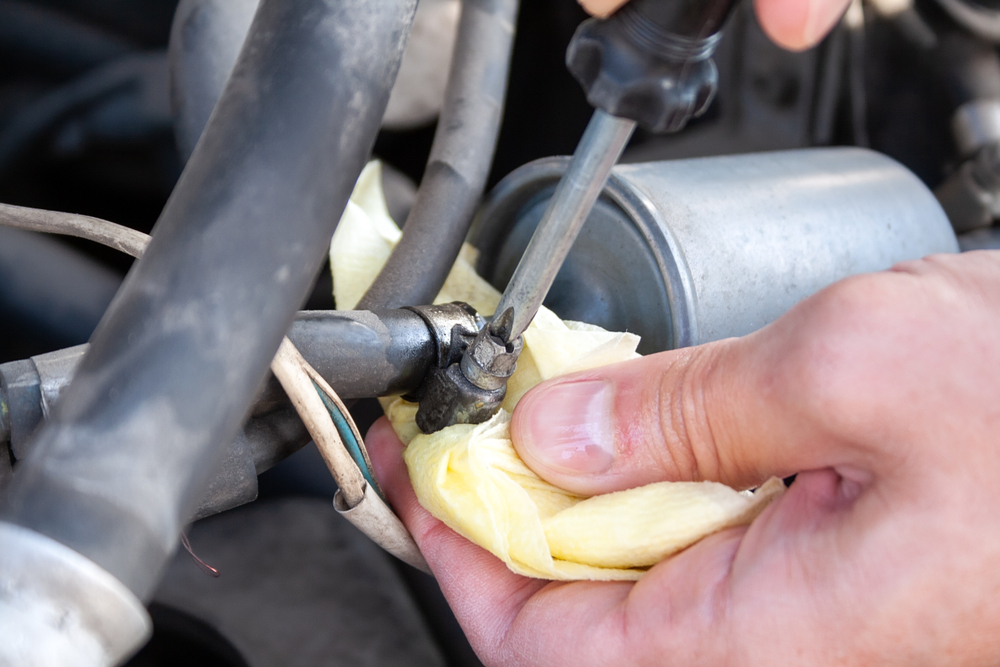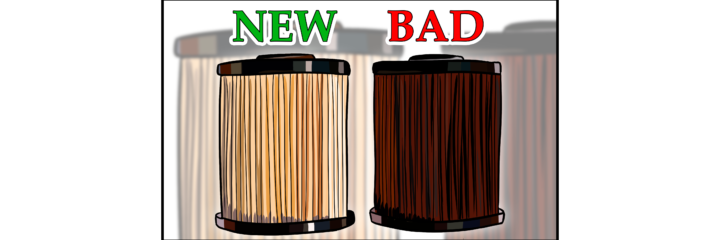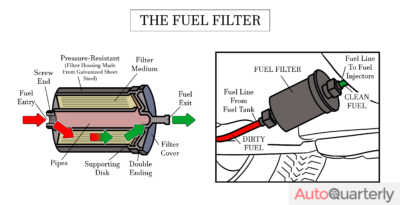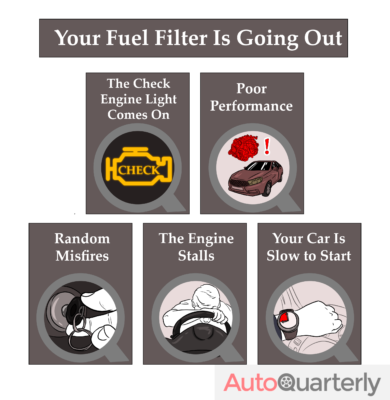The fuel filter is one of the most often overlooked pieces of equipment on your car. Other parts — the engine, the alternator, even the lowly radiator — get all the attention and publicity while your fuel filter toils on in anonymity.
Just because it isn’t celebrated doesn’t mean it’s not important, though. The fuel filter is actually a critical piece of machinery, and if it’s not functioning properly, your entire car’s performance will suffer.
However, many people fail to recognize when their fuel filter is on its last legs, and so they’re unprepared for when it finally kicks the bucket. In this guide, we’ll show you how to spot a failing fuel filter — and how much money you’ll need to have socked away to be able to replace it.
What Does Your Fuel Filter Do, Anyway?
Before we look at what could potentially be wrong with your fuel filter, we should first explain what, exactly, it does.
Simply put, a fuel filter…filters fuel. Ok, we’re done here. Let’s move on quickly, yes?
What, that’s not enough information for you? Fine, let’s take a more in-depth look at these important pieces of machinery.
Gas Isn’t Always Clean
The fact of the matter is that the fuel you put in your car isn’t necessarily pristine. It can be loaded with all sorts of debris, including dirt, paint chips, and even bits of rust.
As you might expect, your engine doesn’t really react well when it sucks in all that junk, and any debris that enters your motor can cause damage — ranging from increased wear and tear to catastrophic destruction.
Older cars are generally better able to tolerate a little bit of gunk in their gas, especially if they have a carburetor, but modern vehicles have extremely tight-tolerance fuel systems. Even a little bit of trash in your fuel can damage your engine.
So How Does the Fuel Filter Help?
The fuel filter is a cylindrical object that attaches to the fuel line somewhere between the gas tank and the engine. It’s usually on the underside of the car, just on the other side of the fuel pump. Some modern vehicles have their filters inside the gas tank, however.
The fuel gets fed through the filter before it reaches the engine. The filter removes nearly all of the debris inside the gas, preventing it from reaching the motor.
Over time, though, all that junk builds up inside the filter, clogging it. Once it becomes loaded with debris, fuel won’t pass through as efficiently — and that’s when you start having problems.
Many manufacturers recommend replacing the fuel filter every 20-30,000 miles, or 1-2 years, whichever comes first.
Newer cars — those with filters inside the tank — can go longer, and typically the filter is only replaced as part of a fuel pump assembly replacement. These vehicles can go as long as 60,000 miles without needing a new filter.
Of course, as with any other piece of equipment, fuel filters don’t always live as long as they’re expected to — and some drivers push them past their breaking point. Let’s take a look at what happens when your fuel filter is on its last legs.
How to Tell if Your Fuel Filter Is Going Out
Most fuel filters don’t just up and die without warning. Typically, you’ll see some telltale signs that something isn’t right before your filter gives out, so if you know what to look for, you won’t be blindsided by their eventual demise.
Below, you’ll find 5 of the most common symptoms of a declining fuel filter. Your car may not show all of these, but any of them is cause for concern.
1. The Check Engine Light Comes On
If your car has a fuel pressure sensor, then a clogged filter can trigger a check engine light. This is the easiest way to discover that you have a problem with your fuel filter.
Not every vehicle has such a warning light, though, so your car might not be able to alert you if something’s wrong. Also, sometimes the diagnostic code will indicate a sensor problem rather than a filter issue, which can be confusing if you’re replacing it yourself.
2. Poor Performance
When the engine isn’t getting enough juice, it has to work a lot harder. That means it’s more likely to overheat and less likely to run efficiently, so your MPG might suffer as a result.
These are early signs of a filter issue, and they’re not as severe as the symptoms that will result when your filter gets truly clogged. Also, there are many reasons why your car’s performance could suffer, so don’t automatically chalk it up to a fuel filter — but don’t ignore the possibility, either.
3. Random Misfires
Another early sign of trouble is the occasional misfire. This happens because a clog in the filter interrupts the flow of gas to the engine, causing it to misfire. This can happen when you’re driving or even when the car’s idling.
Sporadic misfiring is another early warning sign that something is amiss with your fuel filter. As it becomes more frequent, that’s an indicator that the filter is becoming even more clogged, but you shouldn’t wait that long to take action. Have a mechanic take a look under the hood after the first misfire, if you can.
4. The Engine Stalls
There are three things your engine needs to run smoothly: fuel, air, and power. We’re only concerned with the first one at the moment, of course.
If your engine isn’t able to get any sweet gasoline from your fuel tank, it may stall on you. This most often happens when you really romp on the accelerator — so it’ll happen at the worst possible time, basically.
Your car may still start even if your engine stalls while you’re driving. That’s because there’s usually still fuel left in the lines, so the engine can get just enough to get going — but not enough to climb a hill or pass that Ferrari.
It gets worse upon acceleration because that’s when your car needs the most fuel — and that surge brings up all the debris that sank to the bottom of the filter. When there isn’t as much of a need for gas, that junk will sink again, allowing fuel to flow freely again.
The stalling will become more frequent as the filter becomes more clogged, as the debris will stuff the filter even when there isn’t a high demand for fuel. Eventually, the car will become nearly undriveable.
5. Your Car Is Slow to Start
We’re going to ask you to imagine a terrifying scenario. Let’s say you wake up on a Monday morning, stumble out of bed, and reach for the coffee pot. However, when you go to pour yourself a cup, only a tiny dribble comes out — even though the pot is full.
We’re sorry — we know that was a horrific hypothetical, and we will gladly pay for any therapy you need as a result (editor’s note: no we will not). Still, that’s basically what’s happening to your car once your fuel filter becomes clogged.
Your car needs a good amount of fuel to get started, but that gas can’t make its way to the engine if it gets trapped in your filter. That will make it sluggish and slow to turn over whenever you try to start it.
However, a car that will barely turn over usually isn’t due to a fuel filter problem. Chances are, it’s your battery or alternator, or even your spark plugs. However, it’s worth running a pressure test on your fuel system, just in case (and keep your fingers crossed, because a clogged fuel filter is just about the cheapest solution to this problem).
How Much Does a Fuel Filter Cost to Replace?
For such a small piece of equipment, a clogged fuel filter can have a huge impact on how well your car performs. That may cause you to think that replacing it would be an expensive proposition.
As it turns out, though, replacing a fuel filter is both fairly cheap and easy. It’s one of those repairs that you can easily do yourself, although it won’t cost an arm and a leg to have a professional handle it, either.
Most fuel filters cost anywhere from $20 to $60, so if you’re doing the replacement yourself, that’s all you’ll need to spend. If you take your car to a mechanic, you can tack on another $50-100 for the repair.
That’s for fuel filters that are positioned outside the tank on the fuel line, though. If your filter is inside the tank, things will get more expensive, as you’ll need to replace the entire fuel pump assembly.
That can cost anywhere from $200 to $1,000, depending on your car; however, that cost is mitigated by the fact that you can drive about three times as long before needing a change.
Can I Drive With a Clogged Fuel Filter?
To a certain extent, sure. Your car will likely be sluggish and prone to dying at inopportune and potentially dangerous moments, but driving it is certainly possible for a while.
Eventually, though, it will likely be so tedious to drive that you’ll give up on it. That’s especially true given how cheap and easy it is to fix — why would you want to do that to yourself?
You don’t want to push it too far, either. If you drive with a clogged fuel filter for too long, it can damage your fuel pump or other parts of your assembly, turning a small chore into a costly repair.
How to Replace a Fuel Filter

Swapping out a fuel filter is one of the easier maintenance jobs you can do on your car, as all it takes is a few wrenches and a few minutes. This is only for in-line fuel filters, of course; if yours is in the gas tank, leave the replacement to your mechanic.
Getting Started
Start by locating your filter; it’s usually on the underside of the car near the tank. It may help to buy the replacement first, then use it to help you locate your existing filter. If you know how to recognize your fuel line, then it’s simply a matter of tracing it until you come across the filter.
You should understand that the fuel line is pressurized, so some gas will likely spray out when you first unscrew it. You can either deal with this by wearing safety goggles and staying as far away from the spray as you can, or by removing the fuel pump fuse from the fuse box and then running the engine until it dies.
The fuel filter will likely have an arrow on it; this indicates the direction that the liquid will flow. It’s critical that you install the filter with the arrow in the correct direction, so make sure it points towards the engine.
You’ll need a pair of crescent wrenches for the job as well, and possibly a pan to catch any falling gas, but beyond that this is not a tool-heavy chore.
Removing the Old Filter
Once you’ve located the filter, you’ll probably see that it’s held in place by a strap that’s bolted to the frame. You can remove the strap with your wrenches, but don’t do it before you loosen the filter.
To do that, you’ll need to put one wrench on the fuel line and the other on the nut holding the filter in place. Simply unscrew the nut on each end to remove the filter — it’s usually best to start on the side facing the engine, as it will be under less pressure.
Once you’ve unscrewed the nuts on the filter, do the same with the nuts on the strap. This should allow you to completely remove the old filter.
Don’t just toss it in the recycling bin, as that’s illegal in most places. Used fuel filters require specialized draining and handling, so you’ll need to find a company that deals with such items or ask a mechanic to take care of it for you.
Installing the New Filter
To install the new filter, position it with the arrow pointing towards the engine. Then, screw it on to the fuel line and attach the strap. It’s easy as pie.
Once it’s attached, you’ll just need to put the fuel pump fuse back where you found it in the fuse box. When you’re done with that, write yourself a bill for $150 to complete the auto shop experience.
What About Fuel Filters in Diesel Engines?
Most fuel filter problems in diesel engines present themselves in much the same ways as they do in gas engines. You’ll see sputtering, rough idling, difficulty starting, and misfires during acceleration once the filter gets clogged.
However, most diesel engines have a second fuel filter in addition to the one near the fuel tank. The second one is near the engine, and it gives the diesel a final scrubbing before it hits the fuel injectors.
This additional filter is usually easy to swap out as well, and it typically involves performing the same steps you did on the one near the tank. However, some systems are more complicated, so if it looks confusing you should let your mechanic handle it.
Final Thoughts

You may not give much thought to your car’s fuel filter, but it plays a huge role in how well your vehicle runs. Once it starts to get clogged with gunk, your smooth ride will quickly get a lot more choppy — if you can get it going at all.
Fortunately, swapping it out won’t put you in the poorhouse, so there’s little reason to worry once yours bites the dust. It’s one of the few auto repairs that won’t give you fleeting fantasies about robbing a bank — which is good, because a vehicle with a clogged fuel filter makes a terrible getaway car.




